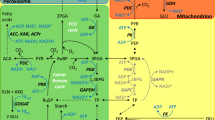Abstract
Isolated epidermes of Tulipa gesneriana L. and Commelian communis L. were exposed to 14CO2 in the light and in darkness, when stomata were either closed or open. The labelling patterns did not differ: the main products of CO2 fixation were malate and aspartate. Small amounts of radioactivity appeared also in acids of the tricarboxylic-acid cycle and their transamination products. Since the capacity of epidermis to assimilate CO2 is known to reside in the guard cells, we can state that guard cells continuously take up CO2 if present, and are thus able to recognize the presence of CO2 in their environment at all times. Epidermal samples exposed to 14CO2 in the light contained only small amounts of radioactive 3-phosphoglyceric acid (3-PGA) and sugar phosphates, or none at all. Epidermal samples from Commelina communis did not contain labelled 3-PGA if all adhering mesophyll cells had been removed before exposure to 14CO2. Homogenates of clean epidermal strips of Commelina communis were able to convert exogenous ribulose diphosphate to 3-PGA at a low rate, but could not catalyze the conversion of exogenous ribulose-5-phosphate to ribulose diphosphate. Guard cells of Commelina communis, and probably also those of Tulipa gesneriana, appear not to possess the reductive pentosephosphate pathway, despite the presence of chloroplasts. In such species, the guard cells will have to rely on import in order to maintain their carbon balance. Earlier findings of photosynthetic reduction of CO2 by epidermal tissues were probably obtained with samples that were contaminated with mesophyll cells.
Similar content being viewed by others
Abbreviations
- Gly:
-
glycine
- PEP:
-
phosphoenol pyruvate
- 3-PGA:
-
3-phosphoglyceric acid
- R-5-P:
-
ribulose-5-phosphate
- RuDP:
-
ribulose-1,5-diphosphate
- Ser:
-
serine
References
Allaway, W.G.: Accumulation of malate in guard cells of Vicia faba during stomatal opening. Planta (Berl.) 110, 63–70 (1973)
Bassham, J.A., Calvin, M.: The path of carbon in photosynthesis. Englewood Cliffs, N.J.: Prentice-Hall 1957
Benedict, C.R.: The presence of ribulose diphosphate carboxylase in the nonphotosynthetic endosperm of germinating castor beans. Plant Physiol. 51, 755–759 (1973)
Hsiao, T.C., Allway, W.G., Evans, L.T.: Action spectra for guard cell Rb+ uptake and stomatal opening in vicia faba. Plant Physiol 51, 82–88 (1973)
Jackson, P.C., Taylor, J.M.: Effects of organic acids on ion uptake and retention in barley roots. Plant Physiol. 46, 538–542 (1970)
Möllering, H.: Determination with malate dehydrogenase and glutamate-oxaloacetate transaminase. In: Methods of enzymatic analysis, vol. 3, pp 1589–1593, Bergmeyer, H.U. ed. Weinheim: Chemie 1974
Nelson, S.D., Mayo, J.M.: The occurrence of functional non-chlorophyllous guard cells in Paphiopedilum spp. Canad. J. Bot. 53, 1–7 (1975)
Pearson, C.J., Milthorpe, F.L.: Structure, carbondioxide fixation and metabolism of stomata. Aust. J. Plant Physiol. 1, 221–236 (1974)
Raschke, K.: Stomatal action. Ann. Rev. Plant Physiol. 26, 309–340 (1975a)
Raschke, K.: Simultaneous requirement of carbon dioxide and abscisic acid for stomatal closing in Xanthium strumarium L. Planta (Berl.) 125, 243–259 (1975b)
Salin, M.L., Campbell, W.H., Black, Jr. C.C.: Oxloaetate as the Hill oxidant in mesophyll cells of plants possessing the C4-dicarboxylic acid cycle of leaf photosynthesis. Proc. Nat. Acad. Sci. USA 70, 3730–3734 (1973)
Shaw, M., Maclachlan, G.A.: The physiology of stomata. I. Carbon dioxide fixation in guard cells. Canad. J. Bot. 32, 784–794 (1954)
Willmer, C.M., Dittrich, P.: Carbon dioxide fixation by epidermal and mesophyll tissues of Tulipa and Commelina. Planta (Berl.) 117, 123–132 (1974)
Willmer, C.M., Pallas, Jr. J.E., Black, Jr., C.C.: Carbon dioxide metabolism in leaf epidermal tissue. Plant Physiol. 52, 448–452 (1973)
Zelitch, I.: Stomatal control. Ann. Rev. Plant Physiol. 20, 329–350 (1969)
Author information
Authors and Affiliations
Rights and permissions
About this article
Cite this article
Raschke, K., Dittrich, P. [14C]Carbon-dioxide fixation by isolated leaf epidermes with stomata closed or open. Planta 134, 69–75 (1977). https://doi.org/10.1007/BF00390097
Received:
Accepted:
Issue Date:
DOI: https://doi.org/10.1007/BF00390097




